By Luis Noe-Bustamante, Lauren Mora and Mark Hugo Lopez
Pew Research Center, August 1,, 2020
Young Hispanic women among the most likely to use the term
Pan-ethnic labels describing the U.S. population of people tracing their roots to Latin America and Spain have been introduced over the decades, rising and falling in popularity. Today, the two dominant labels in use are Hispanic and Latino, with origins in the 1970s and 1990s respectively.
More recently, a new, gender-neutral, pan-ethnic label, Latinx, has emerged as an alternative that is used by some news and entertainment outlets, corporations, local governments and universities to describe the nation’s Hispanic population.
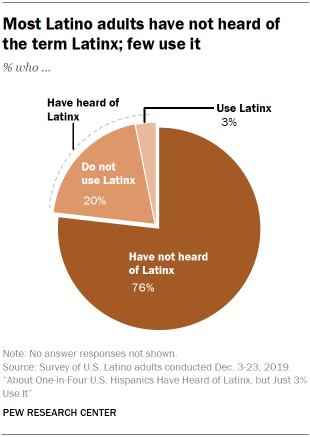
However, for the population it is meant to describe, only 23% of U.S. adults who self-identify as Hispanic or Latino have heard of the term Latinx, and just 3% say they use it to describe themselves, according to a nationally representative, bilingual survey of U.S. Hispanic adults conducted in December 2019 by Pew Research Center.
The emergence of Latinx coincides with a global movement to introduce gender-neutral nouns and pronouns into many languages whose grammar has traditionally used male or female constructions. In the United States, the first uses of Latinx appeared more than a decade ago. It was added to a widely used English dictionary in 2018, reflecting its greater use.
Yet the use of Latinx is not common practice, and the term’s emergence has generated debate about its appropriateness in a gendered language like Spanish. Some critics point to its origins among U.S. English speakers, saying it ignores the Spanish language and its gendered form.1 Still, there are examples of the term’s use in Spanish in the U.S. and abroad.2 Meanwhile, others see Latinx as a gender- and LGBTQ-inclusive term, reflecting a broader movement within the U.S. around gender identity.
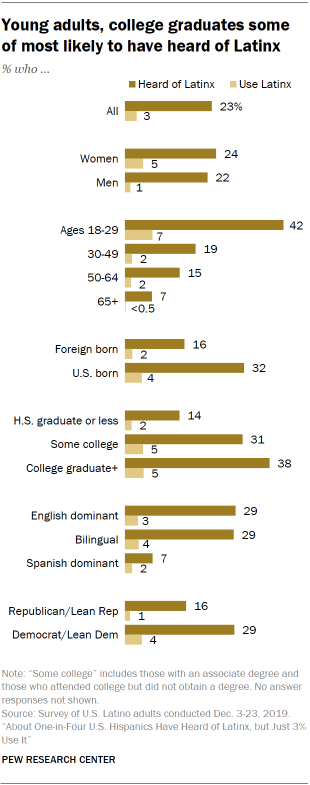
While only about a quarter of U.S. Hispanics say they have heard the term Latinx, awareness and use vary across different subgroups. Young Hispanics, ages 18 to 29, are among the most likely to have heard of the term – 42% say they have heard of it, compared with 7% of those ages 65 or older. Hispanics with college experience are more likely to be aware of Latinx than those without college experience; about four-in-ten Hispanic college graduates (38%) say they have heard of Latinx, as do 31% of those with some college experience. By comparison, just 14% of those with a high school diploma or less are aware of the term.
In addition, the U.S. born are more likely than the foreign born to have heard the term (32% vs. 16%), and Hispanics who are predominantly English speakers or bilingual are more likely than those who mainly speak Spanish to say the same (29% for both vs. 7%).
Hispanics who identify with or lean toward the Democratic Party are more likely to have heard of Latinx than those who identify with or lean toward the Republican Party (29% vs. 16%).

Awareness of the term Latinx does not necessarily translate into use. Across many demographic subgroups, the share of Hispanics who say they use Latinx to describe their own identity is significantly lower than the share who say they have heard it. Use is among the highest for Hispanic women ages 18 to 29 – 14% say they use it, a considerably higher share than the 1% of Hispanic men in the same age group who say they use it.
Google searches for Latinx rising in U.S., but trail far behind Latina, Latino and Hispanic
The relative popularity of Latinx in online searches in the U.S. has increased since 2016, according to a Pew Research Center analysis of Google Trends data.3 While its earliest Google searches extend back to the early 2000s, the highest monthly relative number of searches for Latinx occurred in June 2020, surpassing a previous peak in October 2019.4
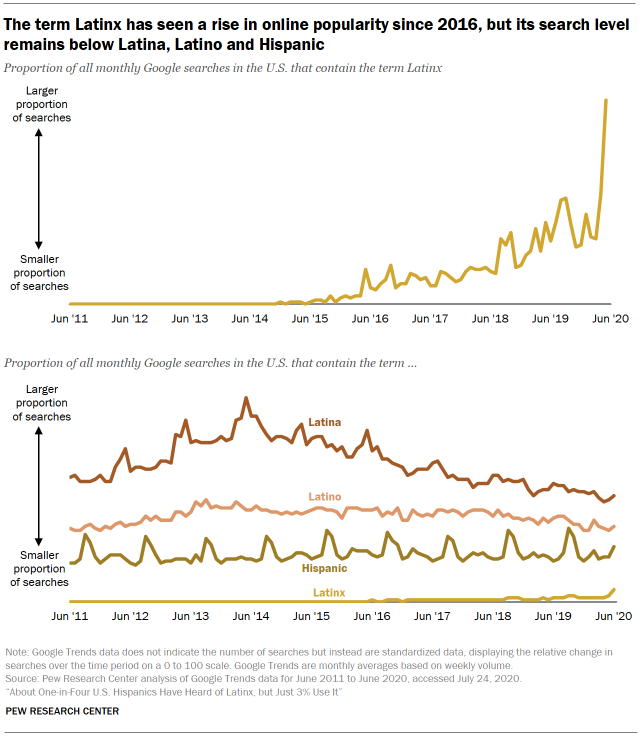
Compared with June 2020, monthly Google searches for Latinx rose substantially for the first time in June 2016, following the Pulse nightclub shooting in Orlando, Florida.5
Despite its increase in popularity, Google searches for Latinx remain below those for Latina, Latino and Hispanic over the past decade. Among these terms, Latina has shown the highest popularity, though its share of searches has been falling relative to its peak in June 2014.6
Should Latinx be adopted as a pan-ethnic term for U.S. Hispanics?
Among those aware of Latinx, one-in-three say it should be used to describe the nation’s Hispanic or Latino population.
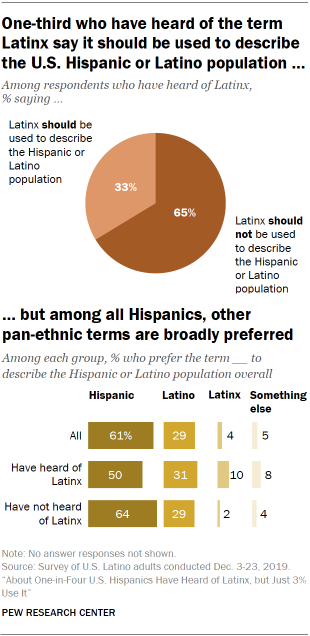
While some Hispanics say Latinx should be used as a pan-ethnic term, few say they prefer it over others. A majority (61%) say they prefer Hispanic to describe the Hispanic or Latino population in the U.S., and 29% say they prefer Latino. Meanwhile, just 4% say they prefer Latinx to describe the Hispanic or Latino population.
Preference for Latinx as a pan-ethnic term is higher among those who are aware of it – 10% in this group say they prefer Latinx. Yet even among those aware of Latinx, the terms Hispanic (50%) and Latino (31%) are preferred.
In their own words: What does Latinx mean to Hispanics?
When asked in an open-ended question what Latinx means in their own words, 42% of those who have heard the term describe it as a gender-neutral one. As one 21-year-old woman said, “Latinx is a more inclusive term to use for those who do not choose to identify with a certain gender. The terms Latino and Latina are very limiting for certain people.”
Other responses from the open-ended question offer other descriptions of Latinx and reactions to it. For example, 12% of respondents who had heard of Latinx express disagreement or dislike of the term. Some described the term as an “anglicism” of the Spanish language, while others say the term is “not representative of the larger Latino community.”
Among other responses, 12% say Latinx is a term about being Hispanic or Latino, while 9% of those aware of Latinx say it is an LGBTQ community inclusive term. And 6% of respondents who have heard of Latinx say it is a new, alternative or replacement term for Latino.
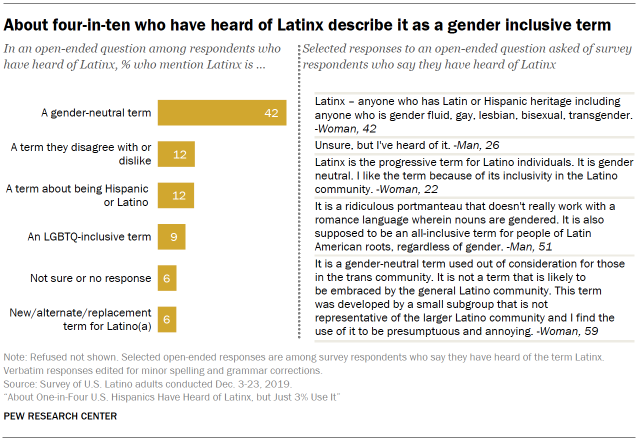
The emergence of Hispanic, Latino and Latinx
Throughout the last half-century in the U.S., different pan-ethnic terms have arisen to describe Americans who trace their roots to Latin America and Spain.
The term Hispanic was first used by the U.S. government in the 1970s after Mexican American and other Hispanic organizations lobbied the federal government to collect data on the population. Subsequently, the U.S Congress passed Public Law 94-311 in 1976, mandating the collection of information about U.S. residents of Mexican, Puerto Rican, Cuban, Central American, South American and other Spanish-speaking country origins. The law called for the U.S. Census Bureau to create a broader category that encompassed all people who identified having roots from these countries. The term Hispanic was first used in a full census in 1980.
The 1990s brought resistance to the term Hispanic, as it embraced a strong connection with Spain, and an alternative term emerged: Latino. By 1997, the U.S. Office of Management and Budget issued a directive adding the term Latino to government publications. The two terms are used interchangeably, with Latino first appearing on the U.S. census in 2000, alongside Hispanic.
More recently, Latinx has emerged as an alternative to Hispanic and Latino. Online searches for the term among the general U.S. population appeared online in the early 2000s. But the first substantial rise in searches (relative to all online searches) appeared in June 2016 following a shooting at Pulse nightclub, an LGBTQ dance club in Orlando, Florida, that was hosting its Latin Night on the date of the attack. In subsequent years, the term’s use on social media by celebrities, politicians and grassroots organizations has grown. In addition, some academic centers at community colleges, public universities and Ivy League universities are replacing Latino program names that were established in previous decades with new Latinx-focused names.
In more than 15 years of polling by Pew Research Center, half of Americans who trace their roots to Spanish-speaking Latin America and Spain have consistently said they have no preference for either Hispanic or Latino as a term to describe the group. And when one term is chosen over another, the term Hispanic has been preferred to Latino. Importantly, the same surveys show, country of origin labels (such as Mexican or Cuban or Ecuadorian) are preferred to these pan-ethnic terms among the population they are meant to describe.
_______________________________________________________________________
- Masculine and feminine nouns are traditionally used in gendered languages. For example, “friends” in Spanish is translated to the gendered “amigos” when referring to masculine friends and “amigas” when referring to feminine friends, and the masculine “amigos” has traditionally been used when referring to a mixed gender group of friends. ↩
- In Latin America, there are also examples of the use of “e” as a gender-neutral replacement in Spanish for “a” and “o” in the ending of words that refer to groups of people – for example, using the gender-neutral “todes” in place of the gendered “todos” and “todas.” ↩
- While no search engine can represent the queries of all Americans, a vast majority of online searchers use Google, and a number of researchers are experimenting with its use as a tool for understanding the public’s attitudes and behaviors. ↩
- While this recent high in Google searches for Latinx in the U.S. can be interpreted as increased interest, it does not indicate the U.S. general public’s opinion about the term or its use. ↩
- The earliest Google Trends data available is from 2004. However, Latinx had been in use in the U.S. before then. ↩
- Google Trends analysis is for the U.S. population overall, including Hispanics and non-Hispanics. It is not possible to limit the analysis to searches done among Hispanics alone. ↩












